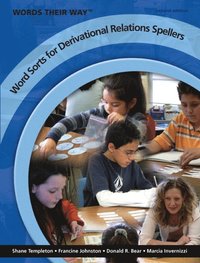
- Format
- Häftad (Paperback)
- Språk
- Engelska
- Antal sidor
- 176
- Utgivningsdatum
- 2008-07-01
- Upplaga
- 2
- Förlag
- Pearson
- Medarbetare
- Johnston, Francine / Bear, Donald / Invernizzi, Marcia
- Illustrationer
- illustrations
- Dimensioner
- 279 x 209 x 6 mm
- Vikt
- Antal komponenter
- 1
- ISBN
- 9780135145784
- 399 g
Kundrecensioner
Fler böcker av Shane Templeton
-
Word Study for Phonics, Spelling, and Vocabulary Instruction (Formerly Words Their Way(tm))
Donald Bear, Marcia Invernizzi, Shane Templeton
-
Development of Orthographic Knowledge and the Foundations of Literacy
Shane Templeton, Donald R Bear
-
Word Study for Literacy Leaders
Anne C Ittner, Shane Templeton
Recensioner i media
Responses from the field
A strength of each chapter is the Notes for the Teacher section that introduces each set of sorts. This reminds teachers about developmental appropriateness and pacing variations based on learner needs. Clearly the gradual release of responsibility model of guided instruction is promoted and reinforced throughout the text.
Barbara Pettegrew, Otterbein College
Chapter layout is excellent. Format is designed to include anything that might be needed for the lesson, and each takes you step by step through the process being taught, allowing time for students to internalize and firm up the skills and strategies.
Susan K. McCloskey, California State University, Fresno
Övrig information
Meet the Authors Shane Templetonis Foundation Professor of Literacy Studies at the University of Nevada, Reno. A former classroom teacher at the primary and secondary levels, he researches the development of orthographic and vocabulary knowledge. Francine Johnston is Associate Professor in the School of Education at the University of North Carolina at Greensboro, where she teaches reading, language arts, and children's literature. A former first-grade teacher and reading specialist. Donald Bear is Director of the E.L. Cord Foundation Center for Learning and Literacy at the University of Nevada, Reno, assessing and teaching students who experience difficulties learning to read and write. A former preschool and elementary teacher, Donald currently researches literacy development with a special interest in students who speak languages other than English, and he partners with schools and districts to consider assessment and literacy instruction. Marcia Invernizzi is Director of the McGuffey Reading Center at the University of Virginia exploring developmental universals in non-English orthographies. A former English and reading teacher, Marcia works with children experiencing difficulties learning to read and write in intervention programs such as Virginia's Early Intervention Reading Initiative and Book Buddies
Innehållsförteckning
Unit III: The Suffix -ion
Sort 14 Adding ion to Base Words, No Spelling Change
Sort 15 Adding ion and ian, no spelling change
Sort 16 Adding ion; e-drop and Spelling Change
Sort 17 Adding ation, -cation, and ition
Assessment for Sorts 14 - 17
Unit IV: Spelling-Meaning Patterns
Sort 18 Consonant Alternation
Sort 19 Vowel Alternation Long to Short
Sort 20 Vowel Alternation Long to Short/Schwa
Sort 21 Adding Suffixe -ity: Vowel Alternation, Schwa to Short
Sort 22 Vowel Alternation, Long, Short, and Schwa
Sort 23 Adding -ion: Vowel Alternation Spelling Change
Sort 24 Multiple Vowel Alternations
Assessment for Sorts 18 - 24
Unit V: Greek and Latin Elements I
Sort 25 Greek Number Prefixes mono- , uni-, bi-, tri-)
Sort 26 More Number Prefixes
Sort 27 Greek and Latin Elements: Size (micro-, mega-, super- hyper-)
Sort 28 Greek Roots (tle, phon, photo, graph)
Sort 29 More Greek Roots (geo, therm, scope, meter, logy)
Sort 30 Latin Roots (spect, port, form)
Sort 31 Latin Roots (dic, aud, vis)
Sort 32 Latin Roots (gress, rupt, tract, mot)
Sort 33 Latin Roots (fract, flect.flex, ject, mist./mit)
Sort 34 Latin Roots (man, scrib/script, cred, fac)
Assessment for Sorts 25 - 34
Unit VI: Greek and Latin Elements II
Sort 35 Latin Roots (duc/duct, sequ/sec, flu, ver/vert)
Sort 36 Latin Roots ( bene, mal) and Prefixes (ante-, post-)
Sort 37 Greek and Latin Elements: Amount (magni, min, poly, omni)
Sort 38 Greek and Latin Elements: Body (cap, corp, dent/dont, ped/pod)
Sort 39 Greek and Latin Elements: (terr, astr/aster, hydra/hydro, bio)
Sort 40 Latin Roots (gen, mort, bio)
Sort 41 Latin Roots (ven/vent, junct, spir, sec/sect)
Sort 42 Latin Roots (jud, leg, mod, biblio)
Assessment for Sorts 35 - 42
Unit VII: Greek and Latin Elements III
Sort 43 Latin and Latin Roots (voc, ling/lang, mem, psych)
Sort 44 Greek and Latin Roots (path, sens/sent, med/medi, sol)
Sort 45 Prefixes (intra-, inter-, intro-, circum-)
Sort 46 Latin Roots (press, pur/purg, fus, pend)
Sort 47 Latin Roots (pos, loc, sist, sta/stat/stit)
Sort 48 Latin Roots (ced/cess/ceed, ten/tend, lit)
Sort 49 Predictable Spelling Changes in Word Roots (ceive/cept, tain/ten, nounce/nun)
Assessemnt for Sorts 43 - 49
Unit VIII: Advanced Spelling-Meaning Patterns
Sort 50 Suffixes (-ent/-ence, -ant/-ance)
Sort 51 Suffixes (-ent/-ence/-ency, -ant/-ance/-ancy)
Sort 52 Suffixes (--able, -ible)
Sort 53 Adding&nbs...
